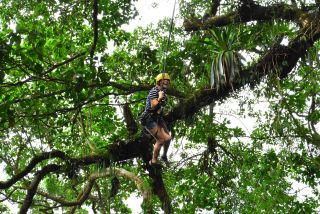Play
A Physical Disability Does Not Have to Limit Play
How can a desire for fun in an adult with cerebral palsy inspire us all?
Updated October 27, 2023 Reviewed by Jessica Schrader
Key points
- Children with cerebral palsy may show differences in play but can be supported to play in very typical ways.
- Maintaining a desire for play into adulthood is important for both those with and without disabilities.
- An adult with a physical disability but an unlimited appetite for fun can inspire everyone around her.

While play seems a natural part of childhood for most children, for others, it can be more of a struggle. For children with cognitive or physical disabilities, recess and play dates might look very different and can be challenging for them and their caregivers to cope with.
Let's focus on one disability, cerebral palsy (CP). My husband’s youngest brother recently married a wonderful woman with CP, and we had the pleasure of accompanying them on their honeymoon trip to Costa Rica. Since my two children were along for the vacation, we included several elements of “play” in the trip, and I wanted to share how wonderful it was to see my 40-something sister-in-law with CP at play.
For children with CP, helping them to play starts in infancy by helping them achieve basic motor milestones such as sitting up (Ryalls et al., 2016). Encouraging hand control as children with CP develop can also foster more productive play (Wolff, 2023). It is important to support play among infants and toddlers with CP because play in these children is associated with higher gross motor function and also with more effective coping behavior (Chiarello et al., 2019).
Once they reach preschool and early elementary-school age, play may look different in children with CP. While they may engage in play that is appropriate to their developmental stage (unlike children with cognitive disabilities), they may need intervention to help develop a narrative or story for their pretend play episodes (dos Santos et al., 2019). A study on play among children ages 6 to 11 with CP found that these children often experience play differently than their peers (Graham et al., 2019). Making choices in play and controlling play were important to them. Children with CP were best able to connect with other children through humor and communication in play. Supporting connection with peers and enabling opportunities for children with CP to play helps them feel like they belong, so play instruction and support of play experiences should be a focus of occupational therapy.
Another form of intervention that has been found to be helpful and that encourages play in children with CP involves virtual gaming systems. These may include real-time adaptations of game parameters to children’s abilities and therapeutic needs (Tresser et al., 2021). VR games have been shown to increase play participation and physical activity in individuals with CP and can even incorporate forms of rehabilitation that can be administered remotely (da Silva et al., 2021).
Physical activity (to the extent possible) is important not only for the physical health of children with CP, but also for their socioemotional well-being. Research has shown that participating in gyms and community exercise systems designed for children with special needs can lead to increases in social engagement, enjoyment of peer mentoring, and improvements in mental well-being (McKenzie, 2023). Similarly, participating in organizations such as the Special Olympics or the CP World Championships can lead to a positive influence on the overall health, quality of life, quality of family life, and quality of social life of children with CP (Groff et al., 2009).

I believe that the importance of play and participating socially in play activities does not end with childhood. Whether one has CP or not, retaining play as part of one’s lifestyle can improve the mental and physical health of adults, as well. This was very evident to me on our vacation with my new sister-in-law, Amanda, and her husband. Costa Rica is known for its extensive zipline courses that criss-cross the rainforest. When I asked her if she was interested in trying ziplining, Amanda’s immediate response was, “Sign me up!” The company we used took several pictures and videos of us on the course, and in every one, Amanda’s face is lit up with a smile from ear to ear.
Not only did she willingly ride along on hundreds of feet worth of zipline, but Amanda also took a true leap of faith—into the jungle on the “Tarzan swing.” The Tarzan swing originates on a 45-foot-tall platform, and swings those who are brave enough to try it out as high as 180 feet above the ground (you can catch videos of this on YouTube). I myself was not brave enough to try it, but Amanda’s approach was, “You only live once!” Despite the sheer terror that I would have felt, Amanda jumped off that platform with gusto and smiled through the whole giant swing.
In addition to ziplining and Tarzan-swinging through the jungle, Amanda, who has some difficulty walking because she does not have full control over both of her legs, hiked with us to see sloths, visit waterfalls, and walk on hanging bridges. After one stumble that left her with a bloody knee, her response was, “This happens all the time. I’m good!” I was so happy that my children were there to witness her carefree attitude. She continued to participate in anything and everything we offered, from ATV rides to kayaking to soaking in hot springs.


The second half of the vacation was spent at the beach. Amanda had never seen the ocean before, and does not know how to swim—in part because of her struggles with motor control from her CP. And yet Amanda plopped herself down at the foot of the shore, let the waves rush over her, even to the point of knocking her down, and went back to her hotel room with a bathing suit full of sand and a huge grin on her face. We took a catamaran ride one day, and when the boat anchored, she jumped right into the water with a noodle and let her new husband help her swim to the shore of “Honeymoon Beach,” because of course, on her own honeymoon, she “couldn’t miss that!”
Amanda’s constant openness to new experience, willingness to take risks, and pure joy in all we did on that trip were inspiring to witness. Physical limitations did not stop her from fully immersing herself in the experience, and getting everything out of it that she could. She came into the vacation with an attitude that she was “ready to play.” Watching her have so much fun led to the rest of us having even more fun ourselves.
I believe that everyone can learn lessons from individuals like Amanda. Whatever life throws at us—physical disabilities, mental or emotional struggles, social challenges—we should all approach situations with the understanding that life is short, and we would really all be a lot happier if we just let go, let ourselves experience that childlike joy, and spent more time playing.




